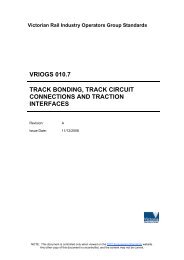Structural Gauge Envelopes - Public Transport Victoria
Structural Gauge Envelopes - Public Transport Victoria
Structural Gauge Envelopes - Public Transport Victoria
You also want an ePaper? Increase the reach of your titles
YUMPU automatically turns print PDFs into web optimized ePapers that Google loves.
VRIOGS 001 Revision B 11<br />
l) 300m: Add 390mm to the horizontal clearance on the inside of the curve and add 135mm<br />
to the horizontal clearance on the outside of the curve<br />
m) 200m: Add 480mm to the horizontal clearance on the inside of the curve and add 200mm<br />
to the horizontal clearance on the outside of the curve<br />
Note these figures are based on a 100mm and 0mm Cant to provide for clearances on the inside and<br />
outside rail on curved track respectively. Where a curve radius value falls between the curve radius<br />
as given in points c) to m), the tighter curve radius shall be used.<br />
Alterations to the structure gauge envelope on curved track that provide allowance for Cant elevation<br />
and rolling stock Centre and End throw may also be derived by the use of the principles outlined in the<br />
Section 11.<br />
If these principles are used it shall be demonstrated to the <strong>Public</strong> <strong>Transport</strong> <strong>Victoria</strong>, Technical<br />
Services Division and to the ARO on how the allowances for curved tracks have been derived.<br />
SECTION 5.0 Deviations and Critical Clearances to Infrastructure<br />
5.1 Deviations from the Minimum Clearances to Infrastructure<br />
Clearances less than the minimum stipulated in this Standard are only permissible on works where<br />
there are alterations to existing track geometry, the installation of additional tracks within an existing<br />
rail environment or where significant physical constraints exist that prohibit complying with the<br />
dimensions outlined in this Standard. No deviations to the minimum clearances outlined in this<br />
document shall be employed in a particular situation if more clearance can be provided. In<br />
cases where existing Infrastructure does not conform to these conditions, refer to section 5.2 for the<br />
absolute limits.<br />
Any deviations to this Standard shall be received prior to the construction/modification of the<br />
Infrastructure. Where deviations are proposed, an ARO shall apply its Engineering Change/Waiver<br />
process to determine if the deviations are acceptable. In the event that an Engineering Change/Waiver<br />
process is approved the absolute minimum conditions as outlined in Section 9 shall be met.<br />
5.2 Critical Clearances to Infrastructure<br />
Critical clearances are defined as those where Infrastructure is situated closer than, or at the<br />
minimum clearance specified in Section 9.0 and cannot be improved without substantial changes to<br />
the Infrastructure. It is only applicable to a specific location and requires the application and approval<br />
of the AROs Engineering Change/Waiver process to demonstrate that the risk of collision is<br />
manageable. It may incorporate site specific track and rolling stock tolerances and may require<br />
conditions to be placed on the location or rolling stock such as a reduction in train speeds or an<br />
increase in inspection or maintenance. Infrastructure that has been identified with a critical clearance<br />
shall be defined as an Identified Structure which is held and updated by the ARO responsible for that<br />
particular railway.<br />
Due to the reduced clearances and the increased risk associated with these it is essential that:<br />
a) The ARO is to conduct a post construction clearance survey to verify that the dimensions<br />
are not less than those specified in the Engineering Change/Waiver process.<br />
b) The actual track design position shall be tied into a monitoring mark/s to enable manual<br />
checking by a track inspector at regular intervals and allow checking after any maintenance<br />
work has been carried out.<br />
NOTE: This document is controlled only when viewed on the VRIOG Engineering Standards website. Any other<br />
copy of this document is uncontrolled, and the content may be inaccurate.

















